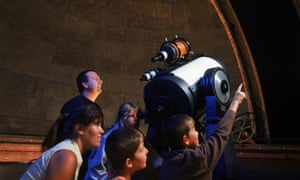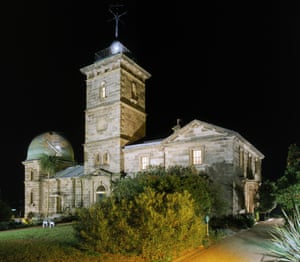Extract from The Guardian
A site once used to guide ships and tell the time focused its attention on the skies in the latter part of the 19th century – and hasn’t looked backA night tour at Sydney Observatory, which sell out weeks and months in advance. Photograph: Powerhouse Museum
Paul Farrell
Sunday 2 April 2017 10.45 AEST
When Australia’s first government astronomer, William Scott, took up his posting in 1858 in Sydney, his equipment was so defective that, according to his diary records, it “destroyed all confidence in the result furnished by it”. And the shutters that were supposed to protect the finely calibrated instruments within the dome let in “a considerable quantity of rain” when the wind was high.
It was an uneasy start to an important mission. But Scott would probably be pleased to learn that the observatory he built in Sydney still stands. And more than 150 years later the dome that looks over the city is continuing to fulfil the role Scott envisioned of opening the stars to all Australians.
“I think people are more engaged than ever,” says Sydney Observatory’s manager, Marnie Ogg. “I think they’re hungry to learn. It’s a science people can get their heads into and it’s a pretty science.
“Even as we lose our dark skies people are getting more interested in the stars.”
For more than 30 years, ever since it became part of the Museum of Applied Arts and Sciences, the observatory has been hosting night tours.
Scott’s records suggest he wanted to build an observatory that was expansive – that was more than just expensive equipment. He wrote that he set out out “to erect an observatory sufficiently comprehensive and commodious to satisfy all the astronomical requirements of the colony for the next century”.
Its construction was approved in 1855 when the government of New South Wales decided it would establish an astronomical observatory; it commissioned a building and salaries for “an astronomer and one computer, and for the purchase of meteorological instruments to be used at various stations in connexion with the proposed observatory”.
Sydney Observatory at night. Photograph: Powerhouse Museum
The budget Scott was allocated to build the observatory and run it was just 7,000 pounds. The imposing stone walls were inspired in part by Italian villas, according to some architects.Scott submitted his first annual report to the observatory board in 1858. His first recordings show that Sydney Observatory may not have even been in the city, had his own vision been realised.
“For purely astronomical purposes I should have preferred a position farther inland, and at a distance from any town,” he wrote, “but as it appeared desirable, for various reasons, that the observatory should be in the immediate neighbourhood of Sydney, I could find no spot more suitable than that recommended by the governor-general, close to the Signal Station at Fort Philip, on which the observatory now stands.
“It possessed the advantages of a good foundation on the sandstone rock of which the hill is composed, an unimpeded view, and a considerable exemption from smoke and dust; moreover, from the extent of the government reserve on which it stands, there will be no difficulty in protecting it from the encroachments of neighbouring buildings.”
Initially the signal station at the site of the observatory guided ships through the weather. As Sydney continued to grow, it realised it needed a way to tell the time. Every day at 1pm a timeball would drop down from the hill, allowing the city to set its clocks. The observatory was also used to predict the weather. The place became the pulse, the heartbeat that kept Sydney alive.
Its role began to turn increasingly to the stars in the latter part of the 19th century. It went from being a local tool to part of a global movement to map the stars.
This vast undertaking was sparked by the development of photography, which opened up an entirely new dimension in the art of astronomy.
“Astronomers, as they always do, jump on that new technology,” says the curator of astronomy at Sydney Observatory, Andrew Jacob. “The idea was to take a photograph of the entire sky. You ended up with an everlasting resource of permanently recorded stars, all objectively taken.”
Each little section of the sky was captured with photography but they needed to be painstakingly transcribed on to tiny plates. This critical role was almost exclusively undertaken by women, according to Jacob, “because they were considered to be much more reliable than the men”.
"There’s
observatories all around the world but they might host one night a
month and pray for good weather"
Marnie OggSydney had an enormous section of the sky, he says, and it was one of the most densely filled. So vast was the project that the imaging alone took from 1891 to the 1920s. But the measuring was not completed until the 1970s.
Over a century, nine government astronomers lived and worked there. The final astronomer, William Humphrey Robertson, oversaw the observatory until 1982 when it became a museum..
From that point the observatory changed once more; it became a place of education. It is this role, arguably, that has been the most significant in bringing the stars to everyday Australians.
The level of interest in the observatory is higher than it has ever been. Some 3,000 schoolchildren visit it each month.
But the biggest drawcard has been the night tours. These visits, open to the public, sell out weeks and months in advance. Almost every evening 100 people will spend an evening in the room, hoping to get a glimpse of the stars.
“Sydney’s very unique in that we’ve got an observatory right in the middle of a city with a dark enough sky that we can actually see things,” Ogg said.
“There’s observatories all around the world but they might host one night a month and pray for good weather, so we’re pretty lucky. There a constant interest. Our issue is that our venue can’t expand to meet the demand.”
The observatory’s story is a part of Australia’s colonial history. But in a Dreamtime astronomy program, started in 2003, stories of the emu in the sky are told.
“It’s a different way of being connected to the sky, and we really like to stress that we’ve lost that connection when Indigenous Australians have not,” Ogg says.
Sydney is brighter now, lights shine all through the night, and the stars get a little harder to see each year. But it is still dark enough to look up in the observatory and peer through the lens of an antique telescope, the latest in a long line of stargazers past.


No comments:
Post a Comment